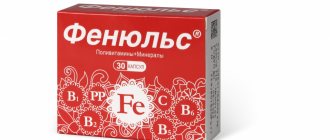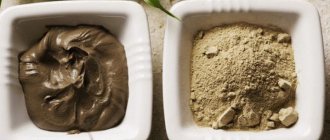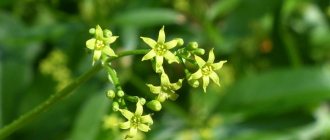In eastern countries, Sophora japonica is highly valued. This is a fairly tall tree with a lush crown with yellow inflorescences. This tree symbolizes beauty and human health.
Quite often the plant was used for decorative purposes, for example, planted in Buddhist temples. They called this plant in a special way - “tree of Chinese scientists.”
The inflorescences inspired creative people to create majestic creations. In addition, healers noted the beneficial effects of sophora on a person’s well-being and health. After all, with its help you can overcome many ailments. After a fairly short period of time, Sophora began to be compared with ginseng. Healers recognized it as a cure for all ailments.
Sophora japonica plant
In ancient China, incredible medicinal possibilities of this plant were discovered. It was a “crying tree” at that time. It received this name because of its crown and its features. It was this that was used to decorate the Buddhist temple.
It was believed that Japanese Sophora had miraculous powers. It was even credited with a mystical effect, because all eastern peoples worshiped this tree. They sincerely believed in the ability to cure almost any ailment and clear negative thoughts. Therefore, many people sought to take advantage of this useful plant.
Beginning in 1747, it began to be bred for decorative purposes. Then the tree was brought to Yalta. It adapted perfectly to the conditions, soon grew up quite quickly, and became popular throughout the Crimean region.
The height is approximately 30 m. This is a frost-resistant plant that easily tolerates drought and fairly large gusts of wind. In its wild form, the tree grows in the Caucasus. In Asian countries you can see the tree, as well as in Crimea.
The fruits and buds are used to prepare medicines. When autumn comes, you can begin collecting them. This procedure is carried out exclusively in dry weather. It is necessary to use a place for drying naturally that will be reliably protected from sunlight. Thanks to such storage conditions, valuable fruits can be saved. You can store such preparations for two years, using them for health improvement and traditional healing.
Compound
The tree has a beneficial effect on the human body and its health due to the characteristics of its chemical component. The necessary raw materials are obtained from the fruits and buds of the tree. Equally, folk and traditional medicine uses the tree for medicinal purposes. A lot of research has been carried out on this topic and the following has been revealed:
- The composition contains alkaloids . This is matrine, for example, pachycarpine. They are better known as poisonous compounds. Interestingly, in small quantities the element is considered an effective medicine. It is able to calm a person and put him to sleep, because it has the effect of a mild sleeping pill. Its presence helps relieve pain and inflammation.
- Also contains flavonoids in an amount of 30% . These glucose compounds are known for their cardiotonic, sedative effect. His presence can relieve spasms. It should also be noted that rutin produces a rejuvenating effect and promotes the accelerated process of regeneration of capillary walls. Its presence contributes to the normalization of metabolic processes. The quercetin content helps reduce blood pressure to an optimal level; the element has an antioxidant effect.
- Contains a group of substances called glycosides . Due to their intake, elasticity and endurance during the functional work of the heart muscle increase.
- Ascorbic acid helps strengthen the walls of blood vessels and increase blood clotting . This remedy can enhance the protective function of the immune system.
- Contains organic acids. They operate in a complex manner. Such acids can relieve a person from inflammation and pain. Their presence kills pathogenic bacteria, fungi, and viruses. Thanks to them, the regeneration of a certain surface of the skin is accelerated.
Note! It is known that Japanese Sophora has a fairly rich composition. It contains important macroelements and microcomponents. Considering the chemical component, it should be noted the presence of a number of useful elements. This is potassium, calcium. You can supplement the list with magnesium and iodine.
Liptin of low density is present in the leaves. The seeds of the healing medicine contain linoleic acid.
Positive Impact
Sophora is often used as a universal cure for all ailments. After all, many diseases are treated on its basis. It is worth considering in more detail the following beneficial properties of Japanese Sophora:
- Thanks to its intake, blood pressure returns to normal. As a result, the walls of the blood vessels relax. This beneficial effect is explained by the presence of alkaloids in the composition;
- There is an acceleration in the dissolution of cholesterol plaques, as well as intravascular blood clots. Certain elements of wood are responsible for strengthening capillaries. They are able to thin the blood and minimize the load on the heart muscle;
- neutralize free radicals. After all, the plant is known for its antioxidant effect;
- based on a medicinal plant, the inflammatory process is relieved, thus removing phlegm. It is worth noting the antibacterial, antiviral effect of natural medicine;
- regeneration, repair of damaged skin areas. The plant is able to heal wounds in a fairly short period of time. Cells are restored, metabolic processes are regulated. In the presence of allergic reactions, Sophora is able to relieve their main symptomatic signs;
- in the presence of swelling, Sophora japonica can eliminate it. Urine output also returns to normal. These beneficial effects can be explained by mild stimulation of the working capacity of the adrenal cortex;
- The functional abilities of the body's defenses are strengthened with its use.
Habitats
Where does Sophora japonica and its other species grow? You can meet the branched Sophora tree in many European countries and beyond. Asia, Altai, the Caucasus, Ukraine, Western and Eastern Siberia and many other regions are considered places of growth.
The tree's favorite places are open sunny places, for example, meadows and valleys. You can see Sophora on rocky slopes, on the banks of rivers and lakes.
In addition to the Japanese sophora, in the territory of the former CIS countries you can also find such species as yellowing sophora and foxtail sophora. These plants also have beneficial properties for the body, due to the presence in their composition of a large amount of tannins, alkaloids, vitamins and microelements. However, it is believed that the Crimean or Japanese species have the greatest benefits; see the photo of the plant in the article.
Indications
A medicine made from this plant can truly be a salvation. Experts identify a number of ailments that can be overcome with the help of sophora.
Diagnosis of cardiovascular diseases
Due to its rutin content, the plant is used to treat heart disease or joint dysfunction. Its presence affects the process of cholesterol removal. Thanks to it, atherosclerotic plaques and blood clots do not form. The plant is able to strengthen the walls of blood vessels and normalize the blood circulation process.
Experts also observe a decrease in capillary permeability after taking the medicine. This promotes the active use of Sophora to combat angina pectoris and atherosclerosis. It is used to quickly get rid of varicose veins and vasculitis. Rutin is an ideal component for carrying out preventive safety measures, minimizing the occurrence of a stroke or internal bleeding in the future.
Gynecological diseases
The plant is able to relieve the inflammatory process, destroy bacteria, and minimize the risk of tumors. Due to its high-quality composition, Sophora is prescribed to relieve inflammation in the uterus and fallopian tubes. Using the plant can stop bleeding.
In general, the reproductive system normalizes its performance. It also helps during menopause, when a woman suffers from unpleasant symptomatic signs. With the help of the plant, unpleasant manifestations are stopped, the woman’s hormonal levels are normalized.
Diagnosis of malignant neoplasms
For malignant neoplasms, this effective natural medicine should be used. It is known that taking it helps stop the growth of pathogenic cells. The components that are included in the high-quality composition of the plant prevent the active progression of the disease. The plant is often used in combination with other medicines, which generally produces a positive effect on the patient’s health.
When diagnosing a malignant neoplasm in the final stages, it is necessary to take this plant. After all, it can relieve inflammation and excessive swelling. In case of exacerbations or during rehabilitation, it is important to support the immune system. Sophora is able to maintain it at the required level.
Diabetes
Another indication is diabetes mellitus. When using the plant, it is necessary to remember the effect on the functioning of the thyroid and pancreas. A number of studies have shown that sophora has hypoglycemic properties. This means that this plant can be used at different stages of the disease.
Pathological changes in the gastrointestinal tract
For pathological changes in the gastrointestinal tract, a natural plant is also used. It can relieve inflammation and stimulate the regeneration process of injured mucosal surfaces. The plant is used in the treatment of giardiasis or helminthiasis.
Diagnosis of kidney and liver disease
During the diagnosis of kidney and liver disease, Sophora is used. After all, it contains quercetin, which is known for its detoxifying effect. This component is able to cleanse the liver and blood of allergens and toxic elements. Doctors also recommend using this remedy after a sufficiently long course of treatment.
Those tinctures that are made on the basis of Sophora are taken orally, used for external or local use. An effective medicine for irrigating the throat, rinsing the gums and mouth.
The tincture is used to relieve unpleasant pain from rheumatism or to get rid of swelling. For this purpose, tinctures and compresses are used.
A decoction based on this plant is also considered an effective remedy. It helps in the fight against skin diseases. It is used for frostbite or burns.
Collection and storage
There are many traditional medicine recipes and medicines that are made on the basis of Japanese Sophora. It is recommended to purchase the finished medicine at a pharmacy at the best price. You can also prepare healing medicine yourself.
To do this, it is necessary to collect unripe fruits, buds that have not blossomed. They have the greatest value. The collection of these parts occurs exclusively in dry weather. At the beginning of the summer season, it is necessary to start collecting fruits. Then they need to be tied up, left in the shade, in a dry place for 2 hours. The fruits should have a green tint.
At low temperatures, the plant loses its beneficial properties.
Popular types and varieties
Sophora japonica (Crimean)
Sophora japonica (Crimean)
It grows in height up to 21-24 m, the crown is spreading, umbrella-shaped or spherical, the bark is dark gray in color, cracks form on the bark. An interesting feature is that in the evening the leaves curl up and droop, and with the appearance of the first rays of sunlight they unfold again.
The flowers are fragrant, yellowish in color, and bloom from July to August. The fruits are beans up to 7 cm in length, formed from October to November.
Sophora yellowish (yellowing)
Sophora yellowish (yellowing)
Herbaceous plant, perennial, height reaches 70 cm. Leaf blades are oblong-ovate, their length is about 5 cm, width is about 2 cm. The flowers are yellowish, bloom in July. The fruits are beans 5-7 cm long. Seeds and roots are used to make preparations.
Sophora thick-fruited
Sophora thick-fruited
Herbaceous plant, perennial, grows up to 0.6 m, has powerful roots. The leaves are oblong-ellipsoidal, up to 2 cm long, the flowers are yellowish, the beans are 60 mm long. The flowering phase begins in April-June, the fruits form in June-August.
Japanese Sophora: tincture
Most often, tincture is used for medicinal purposes. Alcohol, which is a component of the tincture, increases the beneficial effect.
In its finished form, the tincture is used to combat internal bleeding and manifestations of diabetes. In addition, alcohol tincture is used in the course of treatment for hypertensive symptoms and angina pectoris.
Externally, you can treat the burn or injured skin using the product. Medicine is also used for stomatitis or periodontal disease.
For home preparation you will need 56% alcohol and fresh fruits of the plant. Stick to equal proportions. It is necessary to infuse the tincture for three weeks, then filter.
Certain recommendations should be followed when taking the medicine. To a large extent, the dosage depends on the specific disease:
- if the functional functioning of the gastrointestinal tract is disrupted, you need to drink 30 drops about three times a day. In general, the course of treatment using the tincture is approximately 4 weeks. After this, you should definitely take a break for 10 days. If necessary, the course can be repeated;
- when diagnosing a patient with cardiovascular diseases, it is necessary to take 5 teaspoons three times a day. Regular use of the medication should not exceed a month;
- As a preventative measure to minimize the occurrence of a stroke or heart attack, you should take 3 teaspoons of the drug daily. It is necessary to drink the tincture after eating. If necessary, the course should be repeated. Several repetitions per year are acceptable;
- In order to stop inflammation in the oral cavity at an early stage, a tincture, previously diluted with clean water, is used. The components should be mixed in equal quantities. The prepared infusion is used for rinsing;
- If you have skin diseases, you must take the tincture internally. The course lasts approximately a month. It is necessary, together with internal treatment, to use compresses externally on the affected areas of the skin;
- when diagnosing gynecological diseases, the medicine should be used for 21 days. The optimal amount is approximately 15 drops. This course can be repeated 2-3 times a year.
Japanese Sophora: decoction
This medicine is famous for its beneficial effects on the patient’s body. Sophora helps relieve symptomatic signs of a cold.
The plant in the form of a decoction is used to strengthen hair, minimize hair loss, and loss of a vibrant, healthy appearance.
It is necessary to pour 1 tbsp. l. fruits (they must first be crushed), 0.15 liters of boiled water. Then cook the broth for 10 minutes. Next, add boiled water and let the liquid cool. This decoction can be used as a rinse approximately 2-3 times a week.
For a course of therapy aimed at combating tuberculosis, malaria or jaundice, it is necessary to use a decoction of the roots of the tree. To prepare a healing medicine, you need to take 1 tablespoon of the dry Sophora ingredient. Fill them with 0.25 liters of boiled water. Put it on fire. After boiling for 10 minutes, cool and strain the solution.
To achieve the desired effect, you need to take the medicine 5 teaspoons three times a day.
How to care for indoor Sophora
Decorative compact forms of Sophora are grown at home as an indoor flower, and larger ones are perfect for the garden. This plant does not require special care and maintenance of its shape - nature already intended it to have an unusually beautiful shape. Lighting It is advisable to find a well-lit place for Sophora in the room. She is not afraid of direct sunlight, but a little shading will not harm her. You can place a flower pot on the windowsill of an east, west or south window.
Temperature The minimalist, modest tree grows well at room temperature, but in winter it should be moved to a sunny, cool place where the temperature does not drop below +17 degrees. It is important to protect the plant from drafts and hypothermia, otherwise it will shed its leaves. In summer, it can be placed on the balcony or in the garden so that Sophora can enjoy the warm breeze and warmth of the sun. Humidity and watering In summer, Sophora is watered abundantly with settled warm water. Watering is carried out as the top layer of the substrate dries. In winter, watering is more modest. The first time after purchase, the Sophora bush may shed its leaves. Do not be alarmed - with good watering, the plant will soon acclimatize and restore the lost mass. Periodically, you can irrigate the crown of Sophora with fine water mist. This is not necessary, but the plant will be grateful for such attention. Fertilizer When growing indoors, from the end of winter, complex mineral fertilizers begin to be applied every 2 weeks. The plant also responds well to organic matter and, if possible, you can alternate mineral and organic fertilizers. Feeding is stopped in the fall. Pruning A beautiful tree does not require pruning or crown formation. Its branches curl and curl more when left to grow freely. Soil and replanting
Sophora can grow in any soil, even lime-rich soil, the main condition is that it must be well-drained. You can use any store-bought fertile substrate. Sophora is replanted as needed. Young specimens can be replanted as needed every spring, and older specimens can be replanted once every 2-3 years. Protruding roots and stunted growth of the bush can serve as a signal for the need to replace the pot. Sophora is replanted by transfer, and a good layer of drainage is poured onto the bottom of the dish. Propagation at home Sophora can be propagated by seeds or cuttings. Cuttings For cuttings, parts of twigs 10 cm long with several leaves are suitable. The cut areas are treated with Kornevin and planted in a pot filled with a damp peat-sand mixture, and covered with a transparent cup on top. The seedlings are regularly ventilated and moistened the soil in the pot. After they actively begin to grow, the shelter can be removed and the tree placed in a well-lit place. Seeds Before planting, Sophora seeds are poured with boiling water and left for a couple of hours or scarified with a nail file. Sowing is done in pots with a peat-sand mixture to a depth of 2-3 cm, irrigated with water from a spray bottle and covered with film. The dishes with seedlings are placed in a well-lit place and kept at a temperature of +20 degrees. Sophora grows slowly, sprouts appear for a long time, but if all conditions are met, then after a while the first shoots will appear. The first picking is carried out only after the appearance of the first pair of true leaves. The roots are cut by 1/3 and planted in new pots. Grown seedlings are cared for like adult plants.
Combination of drugs
The medicine can be combined with other plants. One of them is mistletoe. It can save a person from neoplasms and has an atherosclerotic effect. The plant restores blood flow and strengthens the immune system. This plant is used in European countries as an effective aid in the fight against cancer. All thanks to its high-quality composition. It contains tannins and saponin-containing substances. The list can be supplemented by the presence of a number of alkaloids, fatty acids, as well as cetyl alcohol.
The combination of two plants is considered an excellent combination. A tincture made from them helps get rid of cancer diseases, atherosclerosis, and hypertension. If the functional functioning of the liver, kidneys or gastrointestinal tract is impaired, the drug is also actively used.
Quite often, traditional healers use this tincture for medicinal purposes. After all, the product helps fight diabetes, skin diseases, and relieves a person from periodontal disease.
Alternative medicine often uses a combination of these plants after a stroke, as well as during chemotherapy.
To prepare the tincture, it is necessary to mix mistletoe and sophora in equal proportions (it is enough to take 1 glass of the plant in dry form). Then pour 1 liter of alcohol into the mixture. The product should be infused for three weeks.
The tincture should be consumed three times daily. Should be 1 tsp. tinctures use 0.1 liters of water.
In general, the duration of the course depends on the characteristics of the patient’s body, the disease and its form. You should remember the need for breaks. For example, between courses you should rest from taking the miraculous remedy for one or two months. If such a need arises, then it is necessary to repeat the course of treatment.
Landing rules
Indoor Sophora quickly grows a crown and rhizome, but it is quite difficult to tolerate transplantation. Even young trees are replanted after a year. For adult plants, the top layer of soil is only replaced. Sophora, like most members of the Legume family, enters into symbiosis with fungi found in the soil. As a result, small whitish compactions form on the roots. For a plant, such a union is very important, so when replanting it is impossible to completely clear the soil from the roots.
The best time for replanting is January-February, before the growing season begins. Sophora does not make great demands on the land. It is only important that it is light and breathable. Often they use universal or garden soil with the addition of river sand. Be sure to add a layer of drainage material to the bottom.
Healing tea
It is believed that tea prepared from this plant has rejuvenating and restorative properties. Regular tea drinking normalizes the functioning of the cardiovascular system, blood pressure reaches its optimal value. A positive effect is noted when applied to hair; the product improves human skin. The plant strengthens the body's defense response and relieves inflammation.
To make tea, mix the flowers and fruits of the plant in equal quantities. You will need 4 tbsp. l. per 1 liter of boiled water. The mixture must be boiled, then allowed to brew. Strain and take a cup of healing tea about three times a day. If desired, you can add dried rose hips. After this, you can drink the healing drink.
Contraindications
Sophora is prohibited during pregnancy (the use of herbal therapy in the first trimester is considered especially dangerous). Sophora should not be used during breastfeeding. In case of individual intolerance, even small dosages of drugs containing Sophora are prohibited.
If the dosage is exceeded, a negative reaction of the body is likely, manifested by vomiting and nausea, diarrhea, stomach pain and intestinal pain and flatulence. If these signs appear when consuming a decoction, tea, tincture, collection or extract with Sophora, treatment should be stopped.









